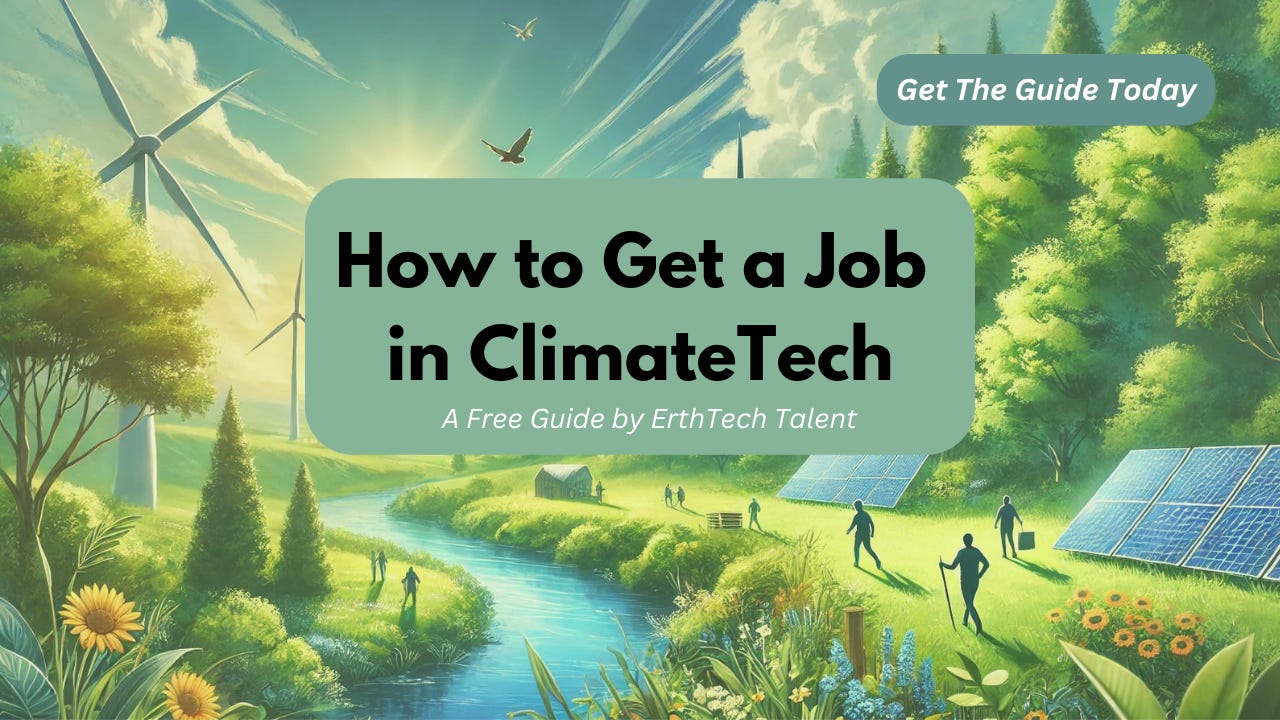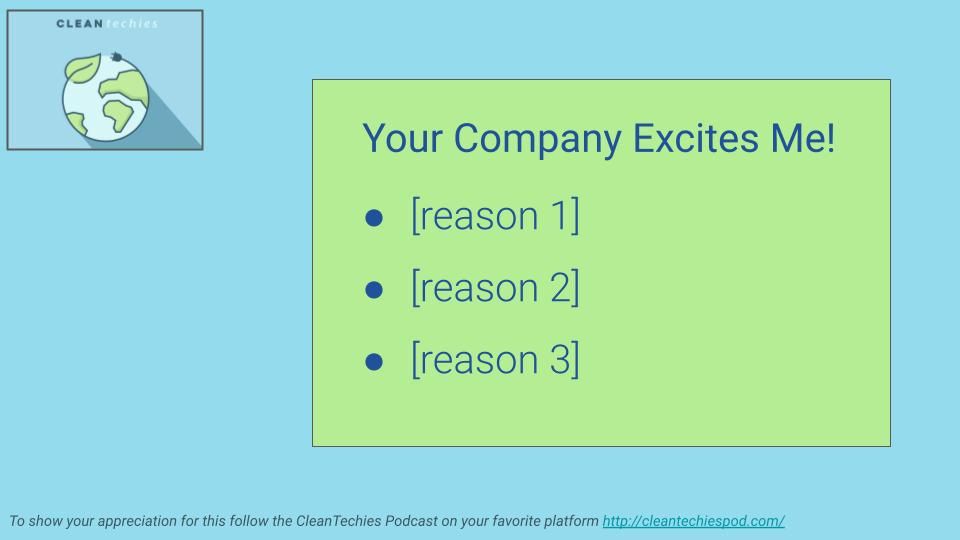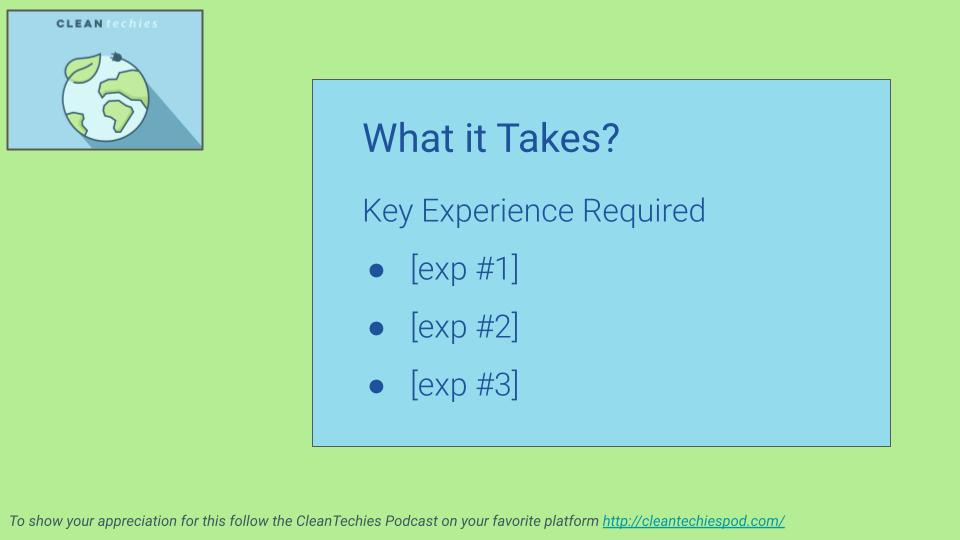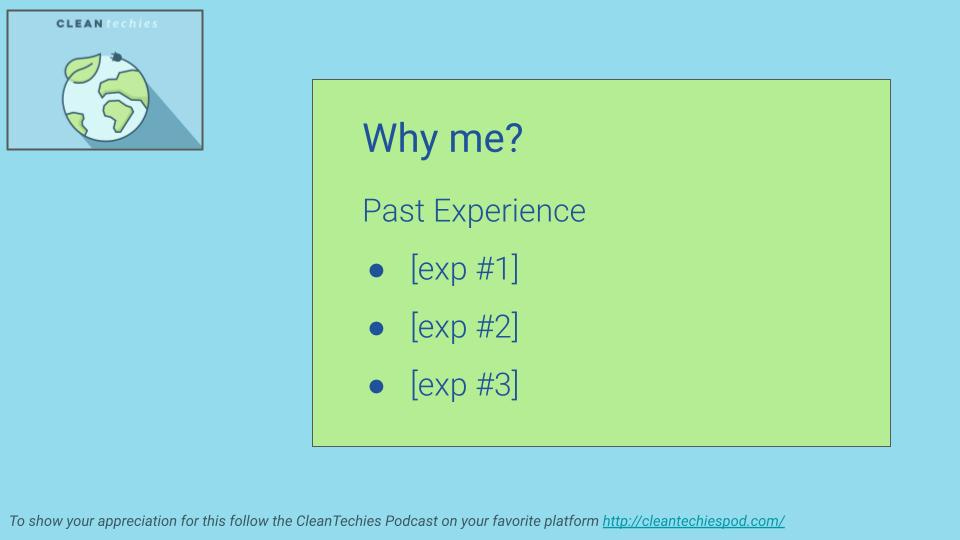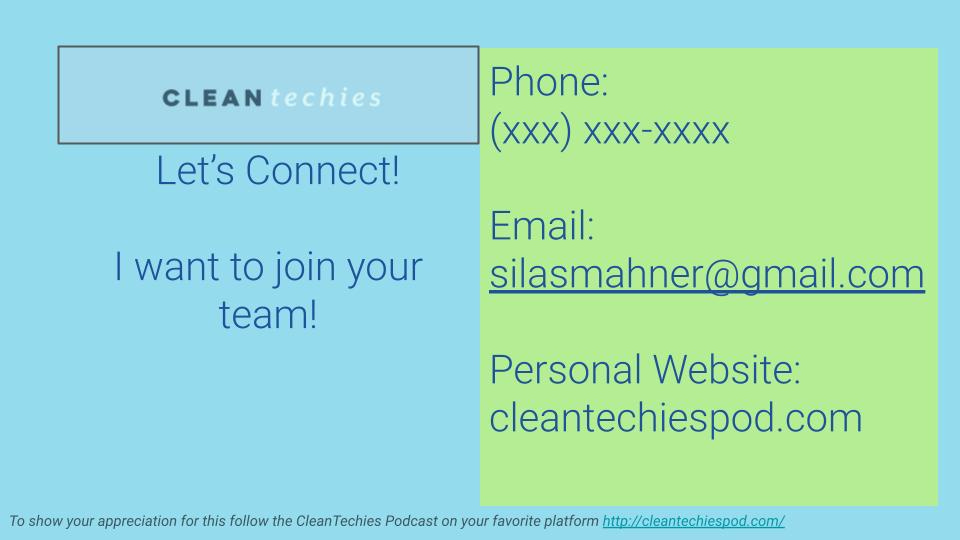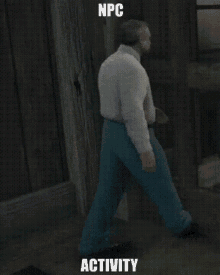As the world continues to convulse due to climate change, more and more people want to be part of the solution.
That’s why hundreds of people reach out to me every month seeking a role in climate.
The problem is, I’m only one man — I can’t help everyone.
In an effort to help more people, I’m re-publishing this guide on how to get a job in climate tech.
I’ll teach you,
How to Identify the Market for You to Target
How to Find Ideal Companies For You
How to Get the Attention of Hiring Managers
How to Pitch Yourself
And What to Do After You Do
To access it, become a free subscriber to this newsletter. If you find it valuable, share it with your friends as well.
(There is additional context at the bottom of this post if you’d like, but the meat and potatoes are right here).
Okay! Let’s dive in!
Step 1: Identify your market
ClimateTech is a very broad statement. There are loads of verticals in ClimateTech, so you need to narrow it down to one or two. Examples of verticals are Electric Vehicle Charging, Carbon Capture, Green Building Technology, Energy Tech, and Battery Recycling Technology. The list could go on for a while. If you’re not at all familiar check out this breakdown from ctvc.co.
In choosing your market/vertical, be realistic. Think about what you have done in the past or what you are doing now. If you focus on getting a green job in the same industry you’re already in, this is the easiest way to achieve your goal.
You can make a total change but be prepared to take a big pay cut.
Step 2: Find Ideal Companies
From here, you want to do some research and find the ideal companies you want to work for in that particular vertical. The best way to do this IMO is to go, again to ctvc.co and look through the capital providers. From here you get a little more narrow into what you want to do.
Go through the portfolio companies of each VC to identify between 10 to 20 of the companies you’re most excited to potentially work for. From these, start doing in-depth research about them, their tech, their founding team, and why they are cool to you.
Once you have done this, you’ll likely be left with 10-15 that you’re still super keen on. This leads us to the next step.
Step 3: Create a 5-Page Slide Deck
After you have in-depth research on each org, create a simple slide deck matching their branding with five slides. Here is a template that you can use to get started.
Slide 1: Intro & Interest
This slide should look something like this. Key points are, to use the brand colors of the company you’re pitching, use their font, and insert their logo. Having an image of you on there is helpful and more personal.
Slide 2: Why [X Company] Excites Me
This slide should demonstrate 3 to 4 key reasons why you’re actually interested in them as a company. Don’t make this generic. Make it something that truly matters to you. Even better if one of the points is something that took more than a surface-level skim of their website to learn.
Slide 3: Demonstrate Understanding
A huge mistake of many job applicants is not GENUINELY understanding the Job Description. Put yourself in the shoes of the hiring manager and company leadership. They have a very particular requisition. They need this person to do a specific job. They need that person, in most cases, to already have DEMONSTRABLE experience in that thing. If you do not understand the job description, then don’t bother applying.
After reading through and understanding the JD, try to boil it down to 3 or 4 key things that they are looking for. If you get close on this, it will win you big points with the hiring manager because you GET IT.
Slide 4: Why You
Here is where you pick 3-4 skills (matching those demonstrated on the previous slide) that you possess. These must be tangible. If a requirement is having run a GHG Accounting Project, and you’ve not ACTUALLY don’t that, you are not doing yourself a favor by saying you have.
Share a few things that you tangibly can bring to the table that correspond with the skills required slide.
Slide 5: Closing & Contact
This is a page with contact information and a call to action.
You can shake this up, of course, but keep it punchy.
Step 4: Record a Video of you Talking to This Deck
Yep. You heard that right. Change into your uncomfortable socks, and let’s make this happen.
This part is critical. The fact that it’s hard is what makes it valuable.
Your video will have a few key components.
Keep it short. Ideally, the pitch is less than 3 min. Longer is really hard to keep their attention.
Don’t script it. Unless you have years of acting experience and can remember lines, don’t bother trying to script it out. Understand and internalize each bullet point and the flow of each page.
Know what you’re saying and why you’re saying it. If you have that, you’ll be able to relay this information naturally, which feels like a conversation.Be sure your face is showing so they can get a feel for you.
Add personality to your voice. Demonstrate your interest through your tone of voice. Monotone is less likely to get you the desired outcome. Remember, most communication is beyond the words being said.
If you know for sure who the hiring manager is, use their name directly.
Here is a video where I walk through the components of each slide and then do an example run-through.
If you're looking for a job in climate, check out this job search tool!
ClimateTechList.com is the web's most comprehensive climate tech job search tool with over 35,000 climate tech jobs from 1,500 companies, updated daily.
Step 5: Send to the Hiring Manager
Going through HR is often very difficult as they are much more by the book. It’s their job to be focused on governance. In any established company, HR is likely going to want everything standardized. So, for that reason, you’re best off going directly to the hiring manager.
Go through their LinkedIn or Website to find the person to who you’d report to. In many job postings, the hiring manager is named or implied. Put your research hat on.
When sending, make the email clear and concise with a good subject line.
An example might look like this.
Step 6: Follow Up
Send a follow-up email if you don’t hear back within 48 business hours. If you can, try to send something of value, like a link to a news article you thought they would find interesting (something related to the industry).
Follow up at least 8 times in various forms before giving up. Connect with them on LinkedIn. Engage with their posts on LI and Twitter. See if you can find a mutual connection who is willing to put in a word for you.
If you try 8 times and don’t get through, try another contact. Persistence is key!
That’s about it.
It may seem like a lot of work, but this will get you an interview. You will have a much higher hit rate than if you are spraying your CV to the world.
Context
If you’re interested in the context mentioned at the start of the post, here you go.
I’ve been a headhunter since March 2020 and have exclusively worked in the Climate, Renewables, and Sustainability space.
I’ll let you in on a little recruiter secret. The only reason we have a job is because most applicants are total robots—or, as my fellow GenZ would say, NPCs.
But here’s the good news—because everyone else is putting in so little effort, it’s easy to stand out!
If people applied to jobs that they were actually close to qualified for, the number of headhunters in the world would be far fewer.
We’re hired to (proactively) find qualified candidates, convince them to take an interview (often, they are only passively looking), manage them through the interview process, and help close them on an offer.
Most recruiters are paid a fee equal to 20-30% of that hire’s first-year base salary.
(In the case of ErthTech Talent, we are much more affordably priced for early-stage climate startups — Seed/PreSeed 10%, Series A 15%, then at B we go to 20%)
Yep! If you’re the right candidate for the job, you’re saving them a recruiter’s fee ($30-50k savings 🤯)
Because of this dynamic, headhunters work primarily for their clients — NOT their candidates. Meaning—we won’t submit you unless you’re the unicorn our clients are looking for.
So what’s the point?
Well, I’m trying to tell you — this is not my first rodeo.
Some candidates find recruiters unhelpful and ruthless, but if the candidate were paying them, it would be a different situation (most are not).
Thanks for reading!
~Silas Mähner
If you're a software engineer wanting to work in climate, check out this resource/company list made by another software engineer:
Was this post a total waste of your time?
No? — Ok, do us a favor.
Heart/Like This (bottom left)
Share w/ another climate job seeker
Follow our “Open Jobs” newsletter (we post whenever we’ve got new stuff for you — this way you won’t miss an opening)
👉 Need help with hiring? Reach out - silas@erthtechtalent.com
👉 Follow
to check out the interviews we do with leading climate entrepreneurs




